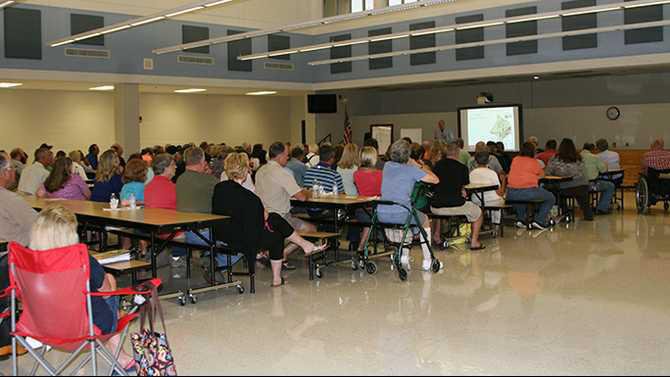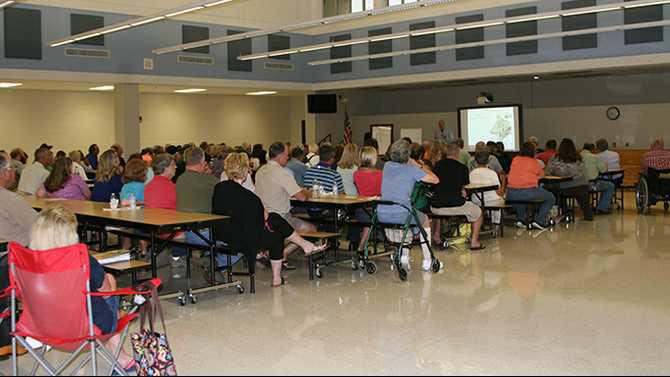Next 2050 Plan public hearings
No. 4
Date: July 29, 2014
Location: Eastside High School
10245 Eagle Drive
Covington, GA 30014
Time: 6:30 p.m.
No. 5
Date: August 7, 2014
Location: Oak Hill Elementary
6243 Georgia 212
Covington, GA 30016
Time: 7 p.m.
Thursday’s public hearing on the 2050 Plan began as did the two before it – with an in-depth discussion of a particular part of the document, in Thursday’s case the “compact communities” and higher-density zoning areas planned for the western part of the county.
But an hour later, when the floor was opened to questions from the public, the refrain was familiar – residents don’t like the 20-acre minimum lot sizes in the eastern and far northern and southern areas of the county. They don’t think the “transferrable development rights” concept will work, with no guarantee of a market. And there’s just something inherently unfair, a few said, about not having a referendum to pass the thing.
Interestingly, the 20-acre bit still has legs.
County Commission Chairman Keith Ellis called the idea of 20-acre minimum lots in conservation districts and 10-acre minimums in rural districts “excessive,” but pledged to establish a citizens’ panel to tell him and other commissioners what might work instead.
“If it’s not 10 and 20, you need to tell me what it is. Is it two and five?”
His comments were met with a mixture of boos for the 20 acres and applause for the much-lower suggestions.
“I wish we could strike (the 20-acre minimums in the ordinance) off right now so we would not have to talk about it anymore,” he told the 200 or so people at Thursday’s hearing in Flint Hill Elementary School near the airport.
“I’m not for the 20 acres,” he explained Friday. “I think there’s very little public support within the community, especially in the rural areas. I have heard this time and time again from my constituents. Repeatedly, I have asked for it to be struck now, (including) a few weeks ago and as late as Monday.”
“Citizens need to help us figure out what they have an appetite for. There is a solution. There is common ground.”
He said the citizens’ panel “could be the place to decide exactly what the (minimize acreage) average should be.”
Hunter Hall, president of the Newton County Chamber of Commerce, said the planners and consultants have “heard you loud and clear in respect to the 20 acres,” and that the Leadership Coalition that put the plan together will convene a subcommittee in coming weeks to look into alternatives.
He said planners don’t want to “knee jerk and just wipe it off.” If the 20-acre minimum is deleted, he said, it’s important to know what that will do to the plan’s focus on clean water, and how and if TDRs will work.
Ellis said the plan “is a tough deal” for the commissioners, and asked attendees Thursday: “How many of you are a little bit mad right now?”
Hands shot up, easily from three-fourths of the people in the Flint Hill cafeteria.
“I’m not really (happy) either,” Ellis said. “What I want to say to you today is this has quite a long way to go. … It might have been taken out of the oven a little too early, but it’s here now.
“I can assure you I can’t see (its passage) happening this year.”
‘Overreach’?
Back on track, Hall asked for civility in future discussions (he got it, with a calm crowd Thursday) and for people with questions to line up and use the microphone so everyone could hear their concerns. He got that, too.
“What I’m hearing tonight seems to be an extreme overreach,” said landowner Scott Jay. He suggested a referendum to pass the zoning. “The whole county should have a vote whether we want to go this route or not. This isn’t Atlanta. We’re kind of taken aback. (Planners) are trying to force-feed something that belongs in larger metropolitan areas.”
Caleb Racicot, who wrote the codes for the 2050 baseline ordinance, reiterated what he’s said in the two previous public hearings: “Under state law you can’t have a (binding) referendum on zoning.”
Non-binding referendums, sure. But he said the state requires government bodies, not referendums, to make changes in zoning.
An unidentified man promptly said he was wrong.
The meetings have been like that.
Jay asked what’s to stop future commissions from rezoning property once the limited number of TDRs generated by land in conservation and rural districts are sold, if they’re ever all sold, from simply rezoning the preserved land and starting over.
“Nothing prevents future commissioners from changing zoning,” Racicot said. “That’s the nature of zoning.”
Farms OK, TDRs a gamble
Other questions Thursday pertained to small farms on land where TDRs have been sold (allowed, Racicot said), homes allowed on smaller lots where they already are (no existing residences will be affected, Racicot said), and the marketability of TDRs (no guarantees, Hall said, just like in any market).
One man pointed on a map to the northern part of the county where he owns land, then pointed to the blank spaces marking the locations of the neighboring Rockdale and Walden counties. “Can we compete?”
The answer is yes, Hall said. Businesses like Baxter appreciate the steadiness and simplicity of the 2050’s consolidation of land uses and zoning districts throughout the county, and understand the savings involved in coordinated public infrastructure. He said a company’s net savings over 50 years would be about 13 percent considering that factor alone.
“That’s bottom-line numbers,” he said. “We actually see it as a very valuable concept to be able to recruit and retain industries.”
Just a draft
Hall and Racicot again emphasized, as in past meetings, that the 2050 Plan is a draft. It’s version 1. After the public hearings are completed, the leadership collaborative will compile comments from the public, make changes, and present version 2 in public hearings for more comment. Version 3 will then be presented to the county and its five municipalities, which can then make changes in several other versions before final adoption.
The numbers the county is facing make planning a must, Hall said. There were 20,000 residents of Newton County in 1950. There are 100,000 today. From 1980 to 2010, Newton County grew 79 percent, adding 78,989 residents, compared with 42 percent growth in the country, 59 percent in the state, and 74 percent in Metro Atlanta. Estimates are for a population of 400,000 by 2050.




